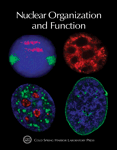|
LXXV: Nuclear Organization & Function 2010 |
|
|

|
From left: J. Claycomb, N. Sher SYMPOSIUM SYNOPSIS LIST OF PARTICIPANTS CONTENTS OF SYMPOSIUM VOLUME PHOTOGRAPHS PUBLISHED VOLUME PRESENTER INTERVIEWS  |
Nuclear Organization & Function
June 2 - 7, 2010
Symposium Synopsis
Organizers: Terri Grodzicker, David Spector, David Stewart & Bruce Stillman
The decision to focus the historic 75th Symposium on the Dynamic Organization of Nuclear Function reflects the growing convergence between descriptive cell-biological approaches to the nucleus and mechanism- driven approaches to nuclear processes that is now illuminating the structural and functional operations of the primary control center of the cell. Many previous Symposia have been devoted to nuclear organization and function, notably Genes and Chromosomes: Structure and Organization (1941), Genetic Mechanisms: Structure and Function (1956), Chromosomes Structure and Function (1973), Chromatin (1977), Structures of DNA (1982), DNA and Chromosomes (1993), and Epigenetics (2004). Every decade has seen important advances in the field, thus it is unsurprising that past Symposia have shed light from many angles on the function of the central organelle of biology.
A major theme of this year's Symposium addressed the emerging relationships among chromosome structure, genome function, and gene expression. Techniques have now emerged that allow the monitoring of chromatin states in cell lines and in vivo using molecular tags and sophisticated microscopy during differentiation. New methods to pinpoint the molecular mechanisms and intranuclear organization underlying transcriptionally active versus inactive chromatin are revealing extraordinary organizational complexity within the nucleus.
Epigenetic mechanisms such as DNA methylation, histone posttranslational modifications such as acetylation and methylation, imprinting, RNA interference, and gene silencing are also subject to dynamic organization in the nucleus. Epigenetic changes are important contributors to the pathogenesis of disease in humans, animals, and plants and may lie at the heart of many important gene-environment interactions. Research is illuminating how epigenetic mechanisms have important roles in regulating the structure and function of the genome, and the 2010 Symposium particularly highlighted the relationships among the genome, epigenome, and nuclear architecture and environment.
The role of signaling in regulating transcription, mRNA export, and chromatin structure was also examined. For example, signaling from or at the nuclear envelope reveals novel mechanisms for influencing nuclear envelope morphology, breakdown, and cell differentiation. Chromatin dynamics was another major theme, both of the chromatin fiber and of chromatin-binding proteins involved in replication and repair, with new results discussed in areas such as the programming of DNA replication origins and their specificity. The latest developments in our understanding of mitotic and meiotic chromosome dynamics, as well as the roles for nuclear transport factors in cell cycle progression, were also covered.
Tremendous progress is also being made in analyzing the mechanisms of assembly for nuclear bodies and their functional roles. Regulated transport into and out of the nucleus through the nuclear pore complex and the operation of selective transport mechanisms also featured prominently, leading to vigorous discussion of the competing models for facilitated transport, as well as reports of new factors required for mRNA export, tRNA shuttling, and pore complex assembly. There is growing evidence that pore permeability and nuclear leakiness change in a regulated way with cell differentiation and age.
The meeting addressed how nuclear organization and function are linked to the underpinnings of several pathophysiological states including the laminopathies such as A-type lamin dysfunction in the premature aging disease progeria and the molecular determinants of cancer-prone symptoms of xeroderma pigmentosum and Cockayne syndrome, of the fatal bone marrow failure syndrome dyskeratosis congentia, and of the Roberts and Cornelia de Lange developmental syndromes. The relationship between nuclear architecture and aging and disease was the subject of a masterful Dorcas Cummings address on "The Unexpected Link between Premature Aging and Nuclear Organization" by Robert Goldman to a combined audience of scientists and lay friends and neighbors.
In arranging this Symposium, the organizers were dependent on the guidance of a broad cadre of advisors including Drs. Robert Goldman, Robert Kingston, Kim Nasmyth, Daniela Rhodes, and Pam Silver. Opening night speakers included John Gurdon, Rob Martienssen, Barbara Meyer, and GüBlobel. Joseph Gall presented the Reginald Harris lecture on "Transcription, RNA Processing, and Nuclear Bodies." Steven Henikoff closed the meeting with a masterful and thought-provoking summary.
This Symposium was attended by more than 400 scientists from more than 25 countries, and the program included 68 invited presentations and 219 poster presentations. To disseminate the latest results and discus- sion of the Symposium to a wider audience, attendees were able to share many of the Symposium talks with their colleagues who were unable to attend using the Leading Strand video archive, and interviews by Sabbi Lall, Emilie Marcus, Richard Sever, and Jan Witkowski with leading experts in the field were arranged during the Symposium and distributed as free videos from the Cold Spring Harbor Symposium Chats website.
We thank Val Pakaluk, Mary Smith, and Ed Campodonico and his staff in the Meetings and Courses Program for their assistance in organizing and running the Symposium, and John Inglis and his staff at Cold Spring Harbor Laboratory Press, particularly Joan Ebert, Rena Steuer, Barbara Acosta, and Kathy Bubbeo for publishing the printed and online versions of the Symposium proceedings. Jan Witkowski (organizer of the 75th Symposium anniversary celebratory meeting that preceded this Symposium) and photographer Connie Brukin captured candid snapshots throughout the meeting.
Funds to support this meeting were obtained from the National Institute of General Medical Sciences, a branch of the National Institutes of Health. Financial support from the corporate sponsors of our meetings program is essential for these Symposia to remain a success, and we are most grateful for their continued support.
Terri Grodzicker
David Spector
David Stewart
Bruce Stillman
Search images: